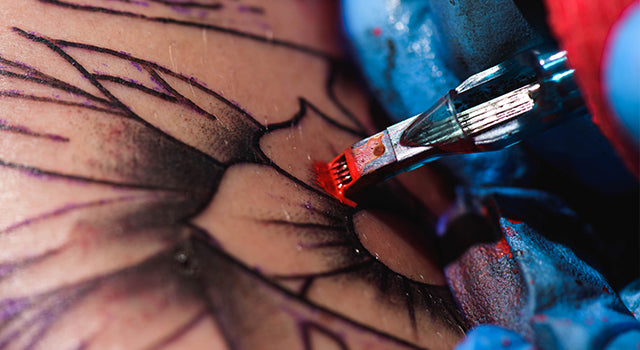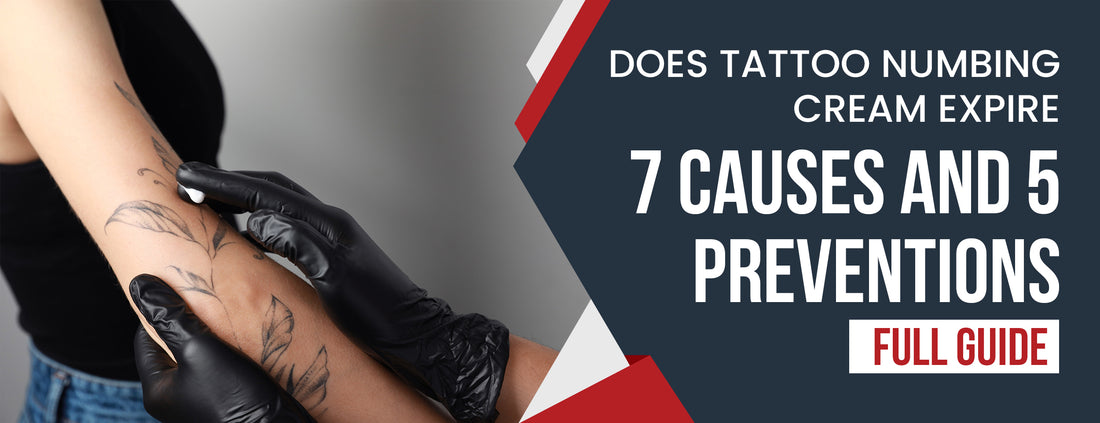The ink absorption into the skin can also be compromised if you use expired numbing cream. This can cause an uneven or unsightly tattoo. To prevent these adverse effects, always check the expiration date on your numbing cream and replace it every six months to a year.
Yes. The cream will either have an expiration date or will be suitable for a certain amount of time after you break the seal. After that time, you shouldn't use it.
In this blog post, we will discuss whether tattoo numbing creams expire, factors affecting their expiration, the potential risks of using them past their end, and storage tips for extending their expiration.
Does Tattoo Numbing Cream Expire: 7 Causes

Many factors can cause the expiration of tattoo anesthesia creams. As a consumer, you must know these factors to use a safe and effective product. This article explores the causes of tattoo numbing cream expiration.
Shelf Life of the Product
A tattoo's shelf life depends on its lidocaine numbing creams varies from product to product, but most are out of date after 2 years. The packaging should contain an expiration date before you purchase or use the product, as an expired numbing cream may not work effectively.
Quality of the Product
Lidocaine has an expiration date, and it's important not to use it beyond that point. A product's quality plays a vital role in defining the expiration of tattoo numbing cream. High-quality numbing creams are likely to last longer compared to low-quality ones. Therefore, it is vital to choose reputable brands known for the quality and efficacy of their products.
The strongest Dr. Numb® 5% lidocaine tattoo numbing cream. one dosage typically lasts 4-6 hours, long enough to sit for most small—to medium-sized tattoos. You'll need to reapply the numbing cream for larger tattoos, requiring more time in the chair.
Storage Condition
Storage condition is another critical factor that influences tattoo numbing cream expiration. Light, moisture, and heat exposure can cause the product to degrade faster. Therefore, storing numbing creams in cool, dry, and dark places is essential. Avoid keeping the product in areas with high humidity, such as bathrooms or kitchens.

Type of Numbing Cream
Different numbing creams exist in the market - cream, gel, or spray. Each product has its unique expiration and storage requirements. Therefore, it is vital to read and follow the manufacturer’s instructions on how to store and use the specific product.
The most common ingredients in extreme numbing creams include lidocaine, tetracaine, benzocaine, and sometimes epinephrine.
Opened or Unopened Product
An opened product may have a shorter shelf life than an unopened one. Once the product is opened, it becomes exposed to bacteria and other environmental factors, which can cause it to degrade faster. Therefore, it is essential to use opened products before their expiry date.
Apply Dr. Numb® thick amount of numbing cream (about 3mm) directly to the fresh tattooing area. People will feel a numbing sensation after applying this tattoo pain less cream that working within 30 to 60 minutes. This numbing cream is a trusted brand that can also help you through before your tattoo appointment and typically expires after 6 months after being opened.
Type of Container
The type of container used to store the numbing cream can also impact its expiration date. The container should be airtight and opaque, preventing air and light from entering. A suitable container should also be easy to close to ensure that the numbing cream stays fresh for an extended period.
Chemical Composition
The chemical composition of tattoo numbing cream can influence the expiry date. As with any product, the ingredients used in formulating the cream can undergo chemical reactions over time, leading to a loss of efficacy or potentially harmful effects.
Leaving excessive amounts of numbing cream on your body can result in the active ingredient being absorbed into your bloodstream. This may cause severe side effects like an irregular heartbeat, seizures, breathing difficulties, or even coma and death.

Tattoo Numbing Cream Expiration Check: Tips
Knowing when your tattoo numbing cream expires is crucial for ensuring its effectiveness and safety. Here’s how you can easily check the expiration date:
Locate the Expiration Date
- Packaging: The expiration date is usually found on the packaging. Look for it on the box, tube, or bottle.
- Common Formats: Dates might be written in various formats like MM/DD/YYYY or MM/YYYY. Make sure you understand the format used.
Check the Batch Number
Some products include a batch number that can help identify the manufacturing date.
- Manufacturer Website: Sometimes, you can check the manufacturer’s website for information related to the batch number and its corresponding expiration date.
Understand Symbols on the Packaging
- Open Jar Symbol: This symbol shows how long the product is good after opening. For example, "12M" means 12 months from the time you open it.
- Additional Indicators: Look for other symbols or notes indicating product lifespan.
Observe the Cream's Condition
- Changes in Texture: If the cream has changed texture, it might have expired.
- Color and Smell: Changes in color or smell are also signs that the cream could be past its expiration date.
Contact the Manufacturer
- Customer Service: If in doubt, reach out to the manufacturer for clarification on expiration dates.
- Product Information: Provide them with details like the batch number and purchase date for accurate information.
5 Storage Tips for Tattoo Numbing Cream to Prevent Expiration

The longevity of tattoo numbing cream depends on proper storage. Here are some tips on how to store your tattoo numbing cream to make it last longer.
Avoid Sharing the Cream
Sharing your tattoo numbing cream can lead to contamination and a shorter expiration. Always use clean hands and a new applicator to avoid cross-contamination.
Keep Cool and Dry
Keep your tattoo numbing cream away from direct sunlight in a cool, dry place. Exposure to heat or sunlight can affect the efficacy of the product. The ideal storage temperature should be between 15 and 30 degrees Celsius.
Keep Away from Moisture
Moisture can cause your tattoo numbing cream to become contaminated or lose its effectiveness. Avoid moisture sources, such as the bathroom or kitchen sink, by tightly sealing the cream.

Don't Freeze the Cream
While avoiding high temperatures is essential, it's equally important not to freeze your tattoo numbing cream. Freezing can cause the cream to separate, making it less effective when used. Sometimes, the cream has turned a pinkish/brown hue upon opening. This change is because of oxidation and poses no cause for alarm.
Do Not Expose to High Humidity
High humidity can affect the quality of your tattoo numbing cream. If you live in a humid climate, store your cream in an air-tight container with a silica gel packet or rice to absorb any excess moisture.
Conclusion
Tattoo numbing cream expires, and using it past its expiration date can be harmful. Make sure the cream is potent and safe by checking the expiration date.
Proper storage and handling also play a vital role in extending the lifespan of tattoo cream. Taking these precautions gives you a pain-free and safe tattooing experience.













![Antibiotics and Tattoos: 3 Risks and 3 Effects [with 4 Precautions]](http://drnumb.com/cdn/shop/articles/Can_You_Get_Tattooed_On_Antibiotics__3_Risks_and_3_Effects_4_Precautions.jpg?v=1714128292)

